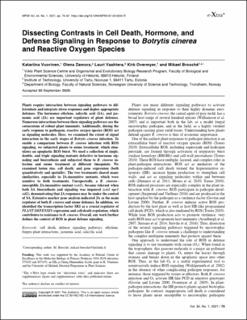| dc.contributor.author | Vuorinen, Katariina | |
| dc.contributor.author | Zamora, Olena | |
| dc.contributor.author | Vaahtera, Lauri | |
| dc.contributor.author | Overmyer, Kirk | |
| dc.contributor.author | Brosche, Mikael | |
| dc.date.accessioned | 2022-09-16T08:39:03Z | |
| dc.date.available | 2022-09-16T08:39:03Z | |
| dc.date.created | 2021-05-20T13:47:40Z | |
| dc.date.issued | 2021 | |
| dc.identifier.citation | Molecular Plant-Microbe Interactions. 2021, 34 (1), 75-87. | en_US |
| dc.identifier.issn | 0894-0282 | |
| dc.identifier.uri | https://hdl.handle.net/11250/3018334 | |
| dc.description.abstract | Plants require interaction between signaling pathways to differentiate and integrate stress responses and deploy appropriate defenses. The hormones ethylene, salicylic acid (SA), and jasmonic acid (JA) are important regulators of plant defenses. Numerous interactions between these signaling pathways are the cornerstone of robust plant immunity. Additionally, during the early response to pathogens, reactive oxygen species (ROS) act as signaling molecules. Here, we examined the extent of signal interaction in the early stages of Botrytis cinerea infection. To enable a comparison between B. cinerea infection with ROS signaling, we subjected plants to ozone treatment, which stimulates an apoplastic ROS burst. We used a collection of single, double, and triple signaling mutants defective in hormone signaling and biosynthesis and subjected them to B. cinerea infection and ozone treatment at different timepoints. We examined lesion size, cell death, and gene expression (both quantitatively and spatially). The two treatments shared many similarities, especially in JA-insensitive mutants, which were sensitive to both treatments. Unexpectedly, a B. cinerea–susceptible JA-insensitive mutant (coi1), became tolerant when both SA biosynthesis and signaling was impaired (coi1 npr1 sid2), demonstrating that JA responses may be under the control of SA. Extensive marker gene analysis indicated JA as the main regulator of both B. cinerea and ozone defenses. In addition, we identified the transcription factor SR1 as a crucial regulator of PLANT DEFENSIN expression and cell-death regulation, which contributes to resistance to B. cinerea. Overall, our work further defines the context of ROS in plant defense signaling. | en_US |
| dc.language.iso | eng | en_US |
| dc.publisher | American Phytopathological Society | en_US |
| dc.rights | Attribution-NonCommercial-NoDerivatives 4.0 Internasjonal | * |
| dc.rights.uri | http://creativecommons.org/licenses/by-nc-nd/4.0/deed.no | * |
| dc.title | Dissecting Contrasts in Cell Death, Hormone, and Defense Signaling in Response to Botrytis cinerea and Reactive Oxygen Species | en_US |
| dc.title.alternative | Dissecting Contrasts in Cell Death, Hormone, and Defense Signaling in Response to Botrytis cinerea and Reactive Oxygen Species | en_US |
| dc.type | Peer reviewed | en_US |
| dc.type | Journal article | en_US |
| dc.description.version | publishedVersion | en_US |
| dc.source.pagenumber | 75-87 | en_US |
| dc.source.volume | 34 | en_US |
| dc.source.journal | Molecular Plant-Microbe Interactions | en_US |
| dc.source.issue | 1 | en_US |
| dc.identifier.doi | 10.1094/MPMI-07-20-0202-R | |
| dc.identifier.cristin | 1911071 | |
| cristin.ispublished | true | |
| cristin.fulltext | original | |
| cristin.qualitycode | 2 | |

